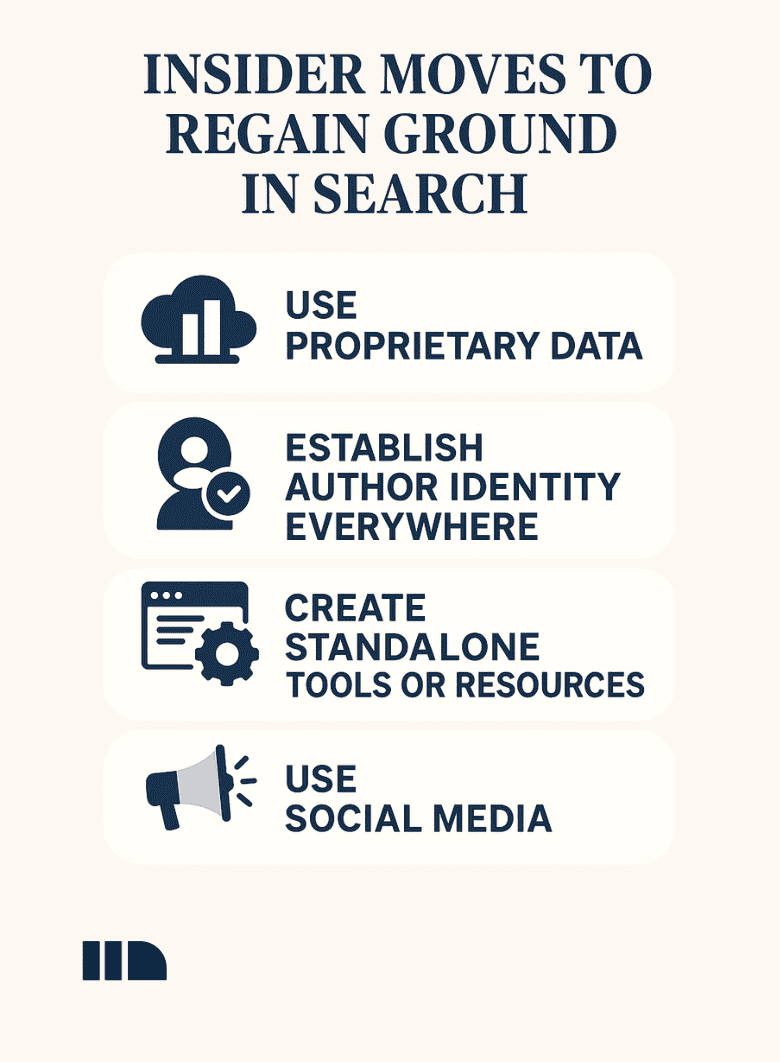Visibility in Google search results has become increasingly difficult for small businesses. Holding a top search position typically leads to greater exposure, increased traffic, and user trust.
However, with the emergence of AI-generated content dominating search results, instances of uncredited content usage, and declining organic click-through rates, the competitive landscape has shifted. Today, businesses may find that their primary competitor is no longer another company—but the search engine itself.
A study by BrightEdge found that over 60% of online experiences still begin with search, yet SGE is expected to cut organic CTR by as much as 25–44%, depending on the query type. And that’s just the beginning.
Luckily, staying visible doesn’t have to be guesswork. With the right approach, you can maintain your online presence without losing ground to Google’s new AI Mode.
How Would We Know?
Based on experience analyzing trends in search engine behavior and helping businesses respond to algorithm changes, we at Mehrana have identified key shifts that impact visibility in AI-augmented search.
You’re about to discover:
- Five strategies that can improve visibility, even as AI-generated answers become more prominent
- Common SEO missteps that can affect rankings in 2025
- Techniques to maintain user attention and brand recognition
- Key observations about AI-generated content and its implications
Let’s get started!
5 Practical Strategies To Help You Stay Visible In Google’s AI Search Era
Some days, keeping your brand visible online might feel like trying to win a game where the rules keep changing. But these five strategies can help you stay in the game.
Understand How Google’s AI Mode Works
Google’s Search Generative Experience (SGE) uses AI to generate answers and place them above organic listings. These answers pull information from various websites and present it as a synthesized response—often without linking to the original source.
This means users can get their answers without ever clicking through to your site, even if your insights helped shape the response.
According to Nielsen Norman Group, eye-tracking studies show users spend 57% of their time on the top of a search result page—meaning if AI answers are at the top, that’s where most attention goes.
If your content isn’t being shown or credited, you’re losing both visibility and traffic. Understanding how Google’s AI Mode works is the first step in responding effectively.
Prioritize Brand-Building Over Keywords
In the past, SEO was about ranking for the right keywords. Today, it’s about becoming a known authority.
AI can summarize facts—but it can’t summarize your brand’s unique voice, credibility, or experience. According to Edelman’s Trust Barometer, 63% of people say they trust content from a brand with a strong personal voice more than generic advice.
Start shifting your focus to producing content with real author identity, first-hand experience, and a clear stance. This makes it harder for AI to paraphrase or remove your brand from the equation.
Lean Into “Un-Googleable” Formats
Google can summarize text, but it can’t easily replicate the value of video, live discussions, tools, and newsletters. These formats deepen your connection with your audience and create experiences that search engines can’t replicate.
Wistia reports that video on landing pages can increase conversion rates by up to 80%. Similarly, email newsletters have an ROI of $36 for every $1 spent (Litmus). This kind of owned content builds resilience.
Focus more energy on these channels—your own newsletter, private communities, or tools behind email opt-ins. These not only insulate you from Google’s ecosystem but also build relationships that don’t rely on a search click.
Reinforce E-E-A-T In Everything You Publish
Google still says it prioritizes content that shows Experience, Expertise, Authoritativeness, and Trust (E-E-A-T).
The difference now is that your content must be the kind that Google can’t easily rephrase. That means using your voice, including personal anecdotes or case studies, publishing proprietary data, and reinforcing your brand identity every chance you get.
Use your real name. Link to other content you’ve written. Include credentials and cite original sources. These signals help both users and Google recognize that your content is credible and brand-specific.
Build Recognition Off-Platform
Organic traffic isn’t the only way to grow.
In fact, as click-through rates drop, channels like email, partnerships, and referrals matter more. The best SEO strategy in 2025 includes off-platform trust signals. When your audience knows who you are before they hit Google, they’re more likely to seek you out directly.
Consider partnering with other brands for webinars, publishing guest content, or creating co-branded resources. This helps you tap into new audiences and build awareness outside of search.
The 3 Most Common SEO Mistakes In 2025 – And How To Avoid Them
As a small business owner, you must make sure your marketing team doesn’t make any of these mistakes:
Chasing Rankings Without Context
Trying to rank for keywords without considering how those keywords show up in AI-generated answers is a losing battle. If Google answers the question directly, your ranking may not matter at all.
Instead: Focus on content that goes deeper than what an AI summary can cover. Think long-form guides, controversial takes, or proprietary comparisons that show your brand’s fingerprint.
Over-Relying On Traffic From Google
Many businesses still treat Google as their only inbound source. When AI shortcuts that path, the impact is brutal.
Instead: Build multiple channels that bring people in—like newsletters, embedded tools, or partnerships. Diversifying channels protects you against changes in search behavior.
Publishing Generic Content
If your content looks like it could’ve been written by anyone, Google’s AI might treat it that way.
Instead: Publish content that demonstrates unique experience, opinion, or original research. Make your brand hard to remove. Include case studies, quotes from team members, or customer feedback wherever possible.
4 Insider Moves To Regain Ground In Search – Starting This Month
Use Proprietary Data
Create original surveys, studies, or case summaries that can’t be easily reworded by Google’s AI. Original data builds trust and authority.
For example, publishing a benchmark study related to your industry—like average conversion rates by traffic source—gives you both search value and citation value. It also ensures that even if Google uses your data, you become the reference point.
Establish Author Identity Everywhere
Tie content to real people. Include bylines, bios, and credentials on every piece of content you publish.
Bonus tip: Add structured data (schema.org markup) to reinforce your content’s connection to real experts. This can improve both ranking and click-through rates while giving Google clearer signals about who stands behind the information.
Create Standalone Tools Or Resources
Free calculators, templates, or checklists behind an email gate create value Google can’t fully absorb—and give you more control over the relationship.
Consider embedding interactive tools directly on your site. Tools like ROI calculators or planning templates serve as lead magnets and reinforce your domain’s usefulness while being harder for AI models to summarize accurately.
Use Social Media
Finally, you should keep updating your authors’ social media profiles. This could be as simple as resharing their articles on their own social media. Doing so will help establish an authority across the web in their niche. You could also share those articles on your company page for added exposure.

The TRUTH About Search in 2025 And Why Most Brands Are Caught Off Guard
Many brands are still playing by old SEO rules—optimizing keywords, watching rankings, and assuming clicks will follow. But Google’s AI Mode changes everything.
Your ideas might still show up—but without your name. Your organic rankings might stay intact—but with fewer people clicking through. And if you’re not actively building awareness outside of Google, you risk fading from relevance.
That’s why you need to adapt now. Because once your content becomes training data and not a source of traffic, it’s already too late.
We’ve helped hundreds of companies adjust to changes in the digital landscape. We can help you make the shift too.
Conclusion
As AI continues to reshape how users interact with search engines, traditional SEO tactics require reconsideration. Businesses that respond by diversifying content formats, emphasizing author credibility, and building recognition beyond search platforms are better positioned to navigate these changes.
While AI-generated responses present new challenges, they also highlight the importance of creating content that reflects originality, expertise, and direct audience value.
Have you adjusted your SEO strategy in response to AI in search? Share your thoughts or questions in the comments below.







